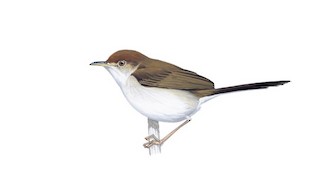
Slender-tailed Cisticola Cisticola melanurus Scientific name definitions
- DD Data Deficient
- Names (22)
- Monotypic
Text last updated November 11, 2015
Sign in to see your badges
Species names in all available languages
| Language | Common name |
|---|---|
| Bulgarian | Черноопашата цистикола |
| Catalan | cistícola cuanegra |
| Croatian | crnorepa šivalica |
| Dutch | Zwartstaartgraszanger |
| English | Slender-tailed Cisticola |
| English (United States) | Slender-tailed Cisticola |
| Estonian | mustsaba-rohulind |
| French | Cisticole à queue noire |
| French (Canada) | Cisticole à queue noire |
| German | Schwarzschwanz-Zistensänger |
| Japanese | オグロイロムシクイ |
| Norwegian | svarthalegressanger |
| Polish | chwastówka czarnosterna |
| Portuguese (Angola) | Fuinha-de-cauda-preta |
| Russian | Чернохвостая цистикола |
| Serbian | Tankorepa šivačica |
| Slovak | cistovník čiernochvostý |
| Spanish | Cistícola Colinegro |
| Spanish (Spain) | Cistícola colinegro |
| Swedish | svartstjärtad cistikola |
| Turkish | Kara Kuyruklu Yelpazekuyruk |
| Ukrainian | Таміка чорнохвоста |
Cisticola melanurus (Cabanis, 1882)
Definitions
- CISTICOLA
- cisticola
- melanurum / melanurus
The Key to Scientific Names
Legend Overview
Field Identification
10–11 cm; 8–10 g. A fairly small, slender, apalis-like cisticola with rufous crown, plain back, and long, slender, graduated black tail with narrow rectrices. Male breeding has lores, eyering and narrow stripe behind eye creamy buff, cheek grey-brown; crown rufous, merging into dark grey-brown upperparts; flight-feathers and greater upperwing-coverts dark grey-brown with rufous margins; tail glossy black with narrow brown margins, outer web of outermost rectrix whitish; buffy below, paler on throat and central belly; iris pale brown; bill dark brown above, pinkish below; legs pink. Non-breeding male is brighter above, reducing contrast between crown and back. Distinguished from C. fulvicapilla and C. angusticauda by slightly longer, glossy black tail and less capped appearance, white-edged outer tail feather, tiny outermost primary (projecting only 6 mm). Female is slightly smaller than male, perhaps more rufous above, and has grey (not white) outer web of outermost rectrix. Juvenile is similar to the adults, although less brightly coloured; upperparts more uniform, with the warm brown head grading into the brown mantle and back, and grey-brown wings (1).
Systematics History
Subspecies
Distribution
NE Angola and SE DRCongo.
Habitat
Confined to Zambezian biome; occurs in miombo (Brachystegia) woodland, often near clearings or more open areas, but not dependent on a grassy ground cover.
Movement
Presumably mostly resident.
Diet and Foraging
Diet mainly insects. Forages in canopy of trees, gleaning foliage like an apalis; sometimes ventures lower down in trees and bushes. Observed to forage in company with hyliotas (Hyliota) and eremomelas (Eremomela).
Sounds and Vocal Behavior
Song, various short burry phrases, at intervals of 1–6 s and usually lasting at least 15 s; contact calls, a soft, weak ‘seep’ and sometimes a sharper ‘chip’; also a clicking, wing-snapping sound made in flight (1).
Breeding
In Angola, a female with oviduct egg in Jan, and a group 6–8 birds, perhaps a breeding pair with several young, in Jul (1). No further information.
Conservation Status
Not globally threatened. Currently considered Data Deficient. A poorly known cisticolid, confined to NE Angola and adjacent DRCongo, both of which areas are difficult of access owing to recent political upheavals and civil wars. A pair was seen in N Angola in Feb 2005, the first observed in the country since 1970s (when the civil war started) (2), and some 8–10 were briefly studied in E Angola in July 2010 (1). Uncommon. Threats unknown, but may be affected by habitat destruction. Lack of information precludes a robust assessment of its conservation status. Information urgently needed on distribution, abundance and ecology (3).

- Year-round
- Migration
- Breeding
- Non-Breeding







































